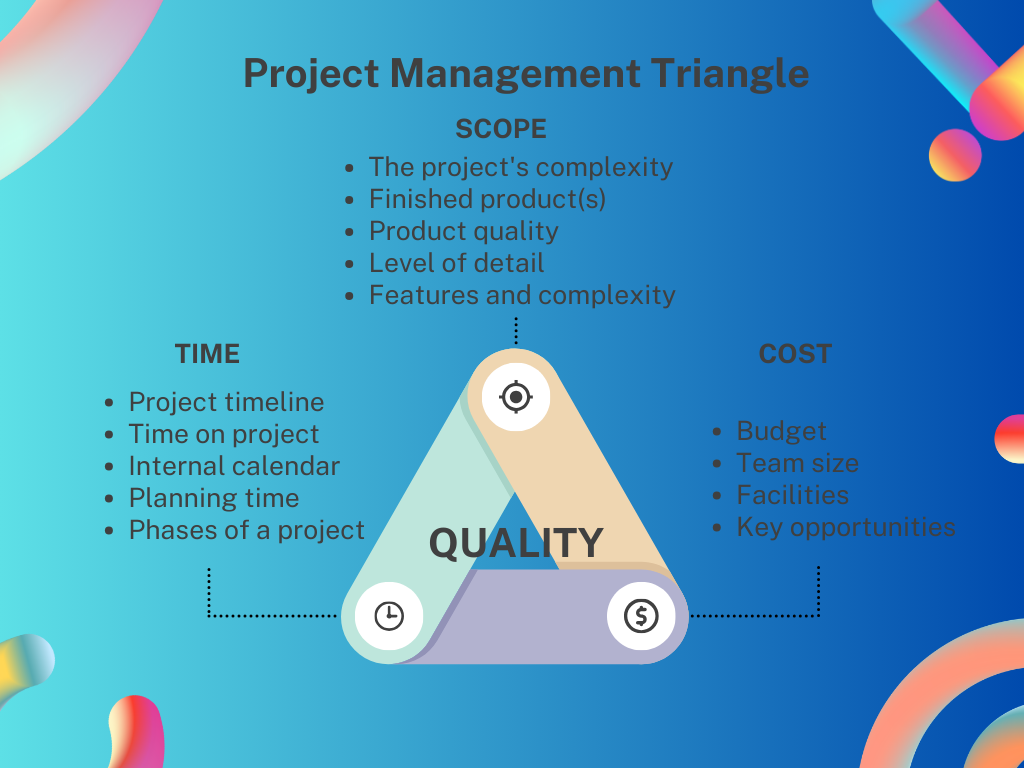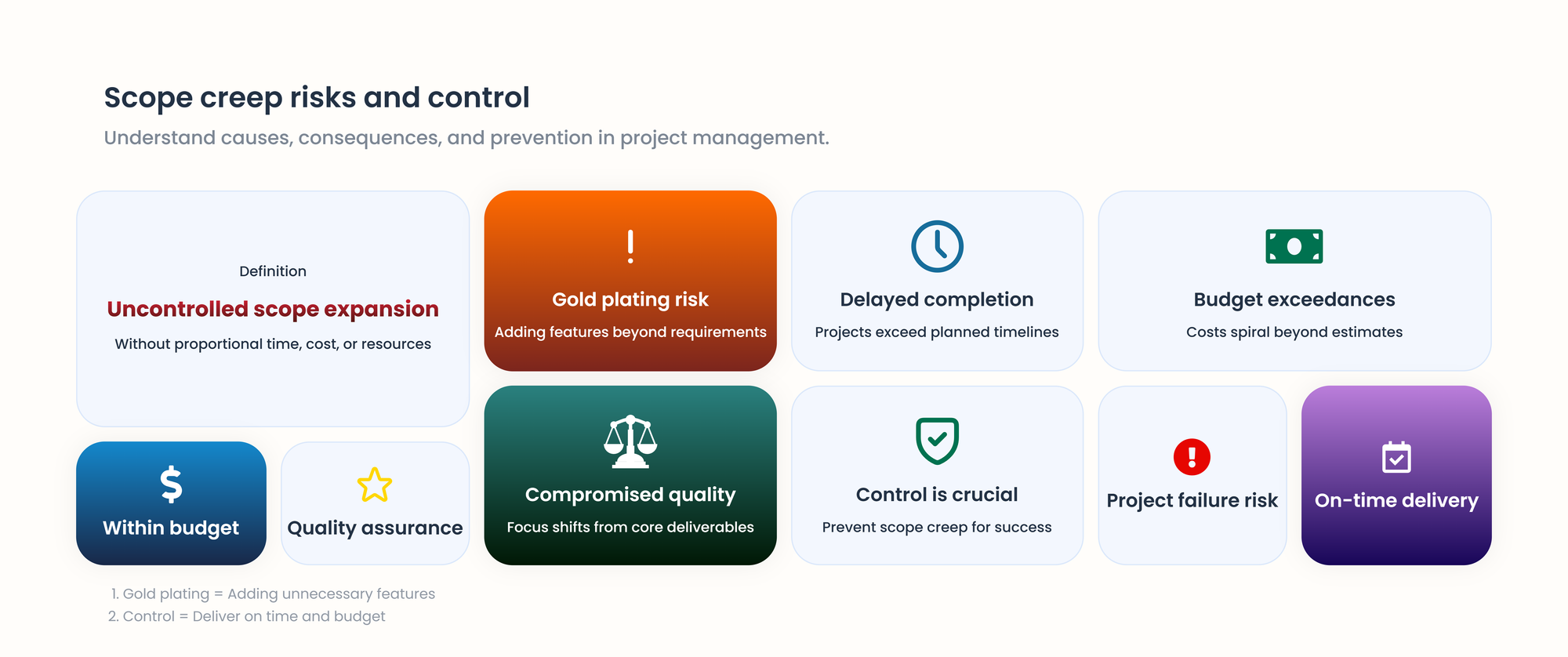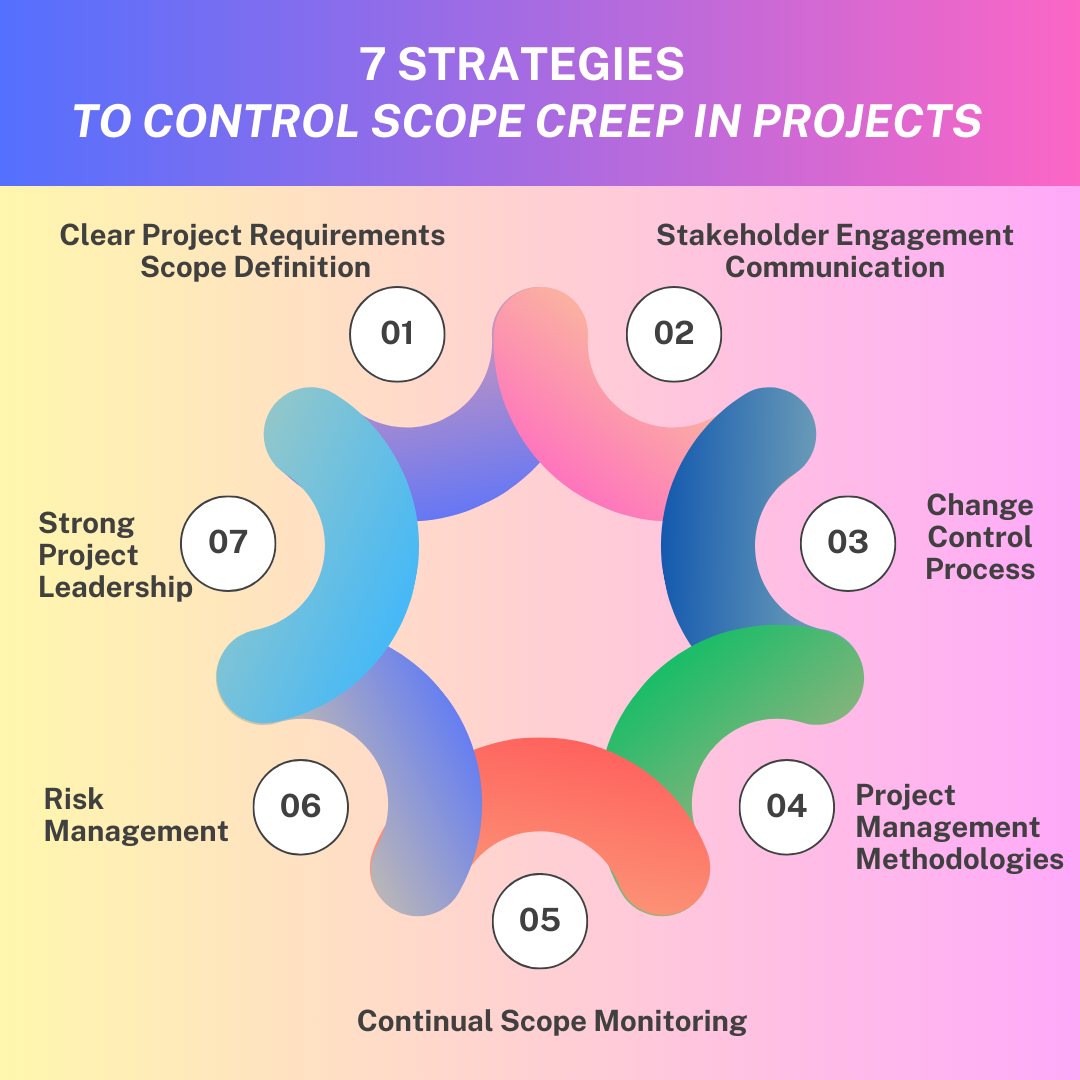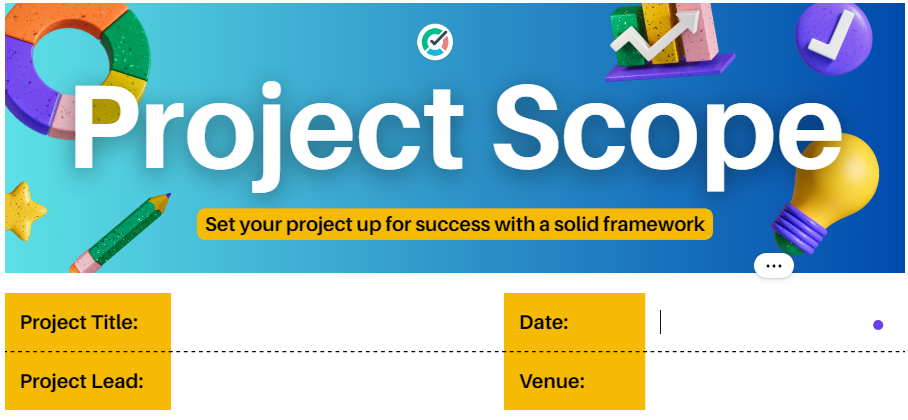The Best 7 Strategies to Control Scope Creep in Projects
To manage scope creep is important in project management. Check out the 7 best effective scope creep control and prevention strategies to succeed in project delivery.

The prerequisite of any project management can be divided into three interwoven aspects, namely the project management triangle, or as it is also referred to as the triple constraint:
- The estimate of the cost of a project
- The schedule of the project
- The features that the project contains.

Understanding Scope Creep
The meaning of a project scope entails the objectives, deliverables, and needs of the project; in other words, what has to be accomplished.
The scope acts as a blueprint, and this sets the boundaries and expectations of the project.
It entails that the scrupulous scope:
- Ensures that an agreement is also mutual as regards the goals and objectives of the project among the involved people
- Can be a delicate management instrument against budgetary blows and resource pressure
- Leads project work activities and project decisions, such as the extension of requirements
- Manages the efficient project governance that supports the change of control
- Ensures appropriate project results in terms of organizational goals and expectations of stakeholders.
What is Scope Creep?

Scope creep transpires in the case of gold plating when the project's scope is expanded without proportionate changes in time, cost, or resources, frequently resulting in:
- delayed completion
- budget exceedances
- compromised quality.
Project management faces diverse challenges, with scope creep posing a significant risk as it can lead to uncontrolled deadline extensions, increased costs, and project failure.
Hence, controlling and preventing scope creep in project management is crucial for successfully delivering projects within their designated timeframes and budgets.
What are Scope Creep Scenarios?
Project scope creep occurs when new elements or requirements are added to an initial plan without equivalent increases in resources, time, or budget.

It should be noted that scope creep examples aren't always negative. Sometimes, incorporating valuable new features or adapting to changing circumstances can be beneficial.
However, it's crucial to be aware of the potential negative impacts and proactively manage them to ensure project success.
The scope creep might be due to a variety of factors.
Communication problems
Unclear or inadequately documented scope: In case the scope of the project is not clearly defined and documented initially, stakeholders stand to make different assumptions on what is in and out.
Lack of communication among stakeholders: When the stakeholders are not updated on the progress of the project and the possible problems that may arise, they may lose their chance to comment, which will result in an uprising in the requests to update the project last minute, and which interferes with the scheduled timeline and cost.
Failure to respond to change request appropriately: It can be ineffective to respond to change requests because change requests may come ad hoc since there is no specific procedure to assess and rank change requests, thus causing improper change handling, complication of projects, and a possible high level of harm on the scopes regarding timelines, costs, and resource distribution.
Project management issues
- Unrealistic expectations: Setting unrealistic deadlines or budgets can cause scope creep as the team struggles to meet these expectations.
- Poor project planning: Without a well-defined plan for managing time, resources, and risks, it's difficult to control the project's scope and prevent creep.
- Lack of change management: Not having a process for managing changes effectively can lead to confusion, rework, and delays.
External factors
- Evolving market conditions: Sometimes, changes in the market or competitive landscape may necessitate changes to the project's scope to remain relevant and competitive. However, such changes must be carefully considered regarding time and resource allocation to avoid project delays and overruns.
- Technical challenges: Unexpected technical issues can require extra work, which can affect the project's original plans and deadlines.
How to Avoid Scope Creep?
To manage it effectively, there are strategies to prevent scope creep that mitigate these risks.
Here are seven of the best ones.

Strategy #1: Establish Clear Project Objectives and Scope
- First of all, start with a clear and unambiguous definition of the scope of the project.
- Add particular deliverables, deadlines, and requirements.
- Be aware and clearly define what the project is and what it is expected to achieve.
- Determine the specific tasks that will help in the attainment of these objectives.
- Write an elaborate scope statement that entails every project feature.
- Identify the limiting factors of the project and assumptions.
- Its proofreading and editing will help make sure that this document is the basis of the project implementation.
💡 Refer back to the scope statement regularly during project meetings to ensure alignment with objectives. Use visual aids like flowcharts or diagrams to illustrate the project scope and objectives for better stakeholder understanding.
Strategy #2: Engage Stakeholders and Sponsors Actively
Communicate the Project Scope to All Stakeholders
- Ensure stakeholders know the project scope, including team members, clients, and management.
- Clarify what is included and what is excluded from the project scope.
💡Use clear, non-technical language in written communications and visual presentations to ensure understanding across diverse stakeholders. Schedule Q&A sessions to address any clarifications.
Involve Stakeholders in Decision-Making
- Engage stakeholders in discussions regarding any changes to the project scope.
- Ensure their input and feedback are considered in decision-making processes.
💡 Set up a structured process for scope change requests that includes evaluation by key stakeholders and decision-makers. To maintain transparency, use a digital platform for tracking and discussing these changes.
Engage with Stakeholders Early and Regularly
- Initiate engagement with all stakeholders early in the project lifecycle and maintain regular contact throughout.
💡Establish regular update meetings or status reports to keep stakeholders informed. Utilize collaborative tools for continuous communication and document sharing.
Maintain Effective Communication Channels
- Implement effective communication channels and provide regular updates to stakeholders.
💡Use project management software that allows for easy updates and visibility into project progress for all stakeholders. Encourage open lines of communication for raising concerns or suggestions.

Strategy #3: Implement a Change Control Process
Prioritize Changes Based on Impact
- Evaluate changes based on their significance to the project's objectives, timeline, and budget.
💡Develop criteria for prioritizing changes, such as impact on project goals, cost implications, and required resources. Use a scoring system to objectively assess the importance of each change request.
Establish a Formal Change Control Process
- Implement a structured process for managing changes to the project scope.
- This should include a change request form for documenting proposed changes and a change control board (CCB) responsible for reviewing and approving these changes.
💡 Ensure the change request form captures all necessary information to make informed decisions, including the rationale for the change, expected benefits, and potential impacts. Regularly schedule CCB meetings to address change requests promptly.
Prioritize Requests for Additional Work or Features Ruthlessly
- When requests for extra work or new features arise, assess them critically to decide which requests align with the project's core objectives and which do not.
- Concentrate on completing the most crucial aspects of the project first. Postpone non-essential tasks or features to later project phases or iterations.
💡 Maintain open communication with stakeholders about why certain features are prioritized over others.
Strategy #4: Use Project Management Methodologies
- Choose project management methodologies and tools that align with your project's specific nature and requirements.
- For projects that benefit from flexibility and frequent reassessment, consider Agile methodologies.
- For projects that demand stringent control and have well-defined stages, traditional methodologies like Waterfall, implying detailed planning and sequential execution, may be more suitable.
💡Assess the project's key characteristics, such as complexity, stakeholder needs, and delivery timelines, to determine the most fitting project management approach. To enhance project tracking and management, incorporate tools that support the chosen methodology, like Kanban boards for Agile or Gantt charts for Waterfall.

Strategy #5: Conduct Continual Scope Monitoring
Monitor Changes to the Project Scope:
- Keep track of any changes to the project scope, ensuring each change is properly documented, approved, and implemented.
💡Employ a digital project management system that features change tracking and notification capabilities to keep the team and stakeholders updated in real time.
Consistently Revise the Project Plan
- Conduct frequent reviews of the project plan to incorporate any scope changes.
💡Schedule regular project review meetings to discuss progress, review the impact of any scope changes, and adjust the project plan accordingly.
Review Project Progress Against Defined Scope
- Perform systematic continuous reviews of the project progress, focusing on task completion, resource utilization, and adherence to the planned timeline and budget.
💡Implement a dashboard within your project management software to visually track progress against key milestones, budget expenditures, and resource allocation. This will allow for a quick overview and detailed analysis when needed.
Strategy#6: Assess Risks
Identify Potential Risks Early
- At the project's outset, identify potential risks, including those that could lead to scope creep.
💡Conduct a thorough risk assessment session with your project team and stakeholders to brainstorm and document potential risks. Structure this assessment using tools like SWOT analysis (Strengths, Weaknesses, Opportunities, Threats).
Develop Mitigation Strategies
- Develop specific strategies to mitigate each identified risk. This might include contingency planning or allocating reserves for time and budget to handle unexpected changes.
💡Create a risk register that details each risk, its potential impact, the likelihood of occurrence, and the planned mitigation strategies. Assign ownership of each risk to a team member for monitoring and response.
Regularly Review and Update the Risk Management Plan:
- Continuously review and update the risk management plan to incorporate and address new risks as they emerge throughout the project lifecycle.
💡Schedule regular risk review meetings as part of the project schedule to reassess existing risks and identify new ones. Update the risk register accordingly and ensure mitigation strategies are executed or adjusted as needed.
Strategy#7: Provide Strong Project Leadership
Effective Leadership for Focus and Direction
- The key to ensuring that the project keeps its integrity is to have the people in charge of the project who are not only good leaders but also good followers.
- They are expected to have skills in negotiation and conflict resolution so as to control the expectations of the stakeholders and match them with the goals of the project.
- Leaders should be able to ardently make choices of either accepting or discarding such changes, taking the best interests of the project at all times.
💡Develop leadership skills by practice, negotiation, frequent decision-making, and conflict resolution. Foster an environment of open communication and transparency to facilitate stakeholder alignment.

Say "No" When Necessary
- The capability to say no to requests that do not belong to the project should be a rule!
- When you must say no, say it sternly but conversationally. Clearly show the reasons as to why the request is in no relation to the objectives of the project or will affect the quality of the final product.
- Provide alternative suggestions on how the changes or functions required can be addressed in future phases of the project or in different (stand-alone) projects.
💡Prepare a template or guidelines for politely declining out-of-scope requests that suggest alternative solutions. This approach helps maintain positive relationships with stakeholders while keeping the project on track.
How to Mitigate Scope Creep with TMetric

TMetric time tracking software empowers you to combat negative scope creep in 5 actionable steps.
Track time automatically: Find out the tasks that cost more than initially estimated and talk about possible scope creep as soon as possible.
Oversee project workload: Resource management software will help you see the belt capacity of your team and stop assigning tasks that can overstretch schedules.
Establish time budget: Establish some time budgets to work and monitor their breaches in time, and mark the possible changes and put them under authority.
Document change requests: Keep a record and evaluate all the variations of the initial scope and point out how they affect time and budget prior to execution.
Construct detailed reports: know what is going on in your projects in terms of time used/lost and resources used/lost, yes, you will be a step ahead of the scope creep lot.
💡Using the time tracking and project management tools like TMetric, you could obtain the necessary information to deal with the scope creep before it knocks you off track.
Concluding Thought
Project managers can implement an improved control of scope creep by never skipping the following steps:
- Making sure that projects are accomplished successfully (by prioritizing planning)
- Discussing and aligning the project goals before accepting them officially
- Eluding the wastes of unneeded overruns or compromises with tracking tools.
Although each project might require a specific use of these strategies, to its particular attributes and challenges, these tactics are effective universally in all types of projects.



